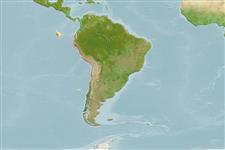Classification / Names
Common names from other countries
Main reference
Size / Weight / Age
Max length : 26.0 cm SL male/unsexed; (Ref. 188)
Length at first maturity
Lm 25.4 range ? - ? cm
Environment
Marine; pelagic-neritic; depth range 0 - 50 m (Ref. 188)
Climate / Range
Tropical, preferred 18°C (Ref. 107945); 0° - 37°S, 86°W - 70°W (Ref. 188)
Distribution
Southwest Pacific: Peru (Puerto Pizarro in Gulf of Guayaquil to Callao and Pisco Bay; presumably to border with Chile, but no records) and Chile (whole coast south to Talcahuano).
Countries | FAO areas | Ecosystems | Occurrences | Introductions
Short description
Dorsal
spines
(total): 0;
Anal
spines: 0;
Anal
soft rays: 12 - 15. Scutes present along back (before dorsal fin) as well as along belly. Upper jaw with median notch. Gill rakers fine and slender, about 130 to 150 in lower limb. Anal fin short, well behind last dorsal fin ray. Scales with pectinated hind border. A dark spot behind gill cover and up to 4 series of vertically oval spots along flank.
IUCN Red List Status (Ref. 115185)
Threat to humans
Harmless
Human uses
Fisheries: commercial
More information
ReferencesAquacultureAquaculture profileStrainsGeneticsAllele frequenciesHeritabilityDiseasesProcessingMass conversion
Tools
Special reports
Download XML
Internet sources
Estimates of some properties based on models
Phylogenetic diversity index
PD50 = 1.0000 many relatives (e.g. carps) 0.5 - 2.0 few relatives (e.g. lungfishes)
Trophic Level
2.1 ±0.0 se; Based on diet studies.
Resilience
High, minimum population doubling time less than 15 months (Assuming tm=1)
Vulnerability
Low to moderate vulnerability (28 of 100)
Price category
